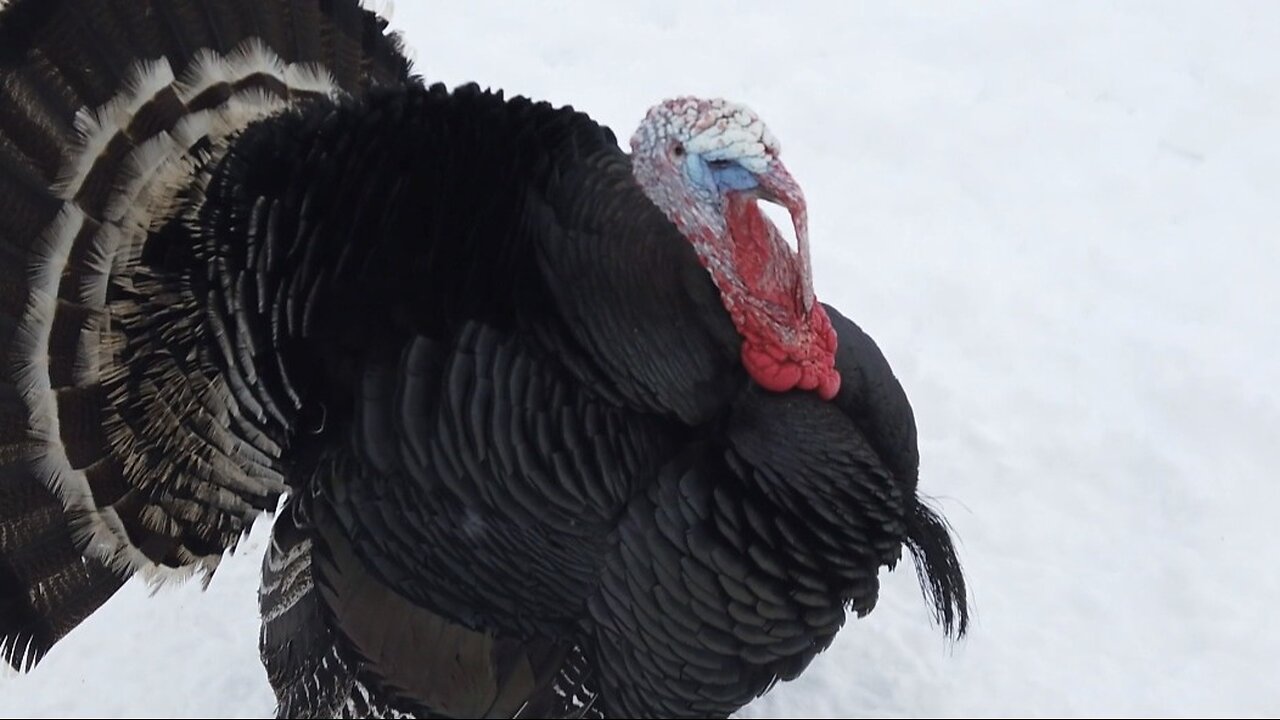Premium Only Content

"Wild Turkeys: Majestic Birds of North America"
The wild turkey (Meleagris gallopavo) is a large bird native to North America, known for its distinctive appearance and importance in ecosystems and cultural traditions, particularly in the United States.
Physical Characteristics
Turkeys are robust, with long legs and wide, fan-shaped tails. They can grow up to 4 feet (1.2 meters) in length and weigh between 11 to 24 pounds (5 to 11 kg), with males being larger than females. Male turkeys, called toms or gobblers, are noted for their iridescent feathers, which can shift in color from bronze and copper to shades of green and gold. They have a bare, reddish head that turns blue or white during courtship or excitement.
One distinctive feature of turkeys is the fleshy, bumpy structure called a snood that hangs over the beak of males. They also have a wattle, the fleshy skin that hangs from their necks. The males display their tail feathers in a fan during courtship and make a characteristic gobbling sound to attract females.
Habitat and Range
Wild turkeys are found in diverse habitats, including forests, grasslands, and swamps across North America. They prefer wooded areas near clearings for feeding. Originally found in the eastern U.S., wild turkey populations now inhabit most of the contiguous United States and parts of Canada and Mexico, following successful conservation efforts.
Behavior
Turkeys are social animals, often forming flocks, especially during winter. They are ground foragers, feeding on a varied diet including seeds, nuts, fruits, insects, and small reptiles. Although turkeys primarily walk or run on the ground, they are strong fliers and can fly short distances to escape predators or reach their roosts in trees at night.
Turkeys are diurnal, meaning they are most active during the day, foraging for food and socializing. In the spring, males gather to perform elaborate displays to attract females, known as hens. This involves puffing out their feathers, spreading their tails, and gobbling.
Reproduction
Mating season occurs in the spring, and males compete for females by displaying their plumage and making calls. After mating, the female will lay a clutch of 10-14 eggs in a shallow nest on the ground, often hidden under brush or tall grass. The incubation period lasts about 28 days. Once hatched, young turkeys, called poults, are cared for by the mother and grow quickly. Within a few weeks, they can start foraging for themselves.
Predators and Threats
Turkeys face natural predators like foxes, coyotes, raccoons, and birds of prey, particularly when they are young. Their sharp senses, including excellent vision and hearing, help them evade threats. Habitat loss and hunting are challenges to turkey populations, though regulated hunting helps manage their numbers today.
Domesticated Turkeys
The domesticated turkey, bred primarily for its meat, is descended from wild turkeys in Mexico and was brought to Europe by Spanish explorers in the 16th century. Domesticated turkeys are usually heavier, with white feathers and a less vibrant plumage than their wild counterparts.
Cultural Significance
Turkeys hold a special place in American culture, particularly as a symbol of Thanksgiving. The bird was also highly regarded by Native American tribes, who used its feathers for ceremonial purposes and consumed its meat.
In summary, the wild turkey is a remarkable bird with fascinating behaviors, a wide range of habitats, and significant cultural importance.
-
 1:15:07
1:15:07
Kim Iversen
1 day agoThe Left Is Dead — What And Who Will Rise From the Ashes?
76.6K56 -
 LIVE
LIVE
Joker Effect
46 minutes agoYOU DON'T UNDERSTAND FREEDOM OF SPEECH IF THIS MAKES YOU MAD!
281 watching -
 LIVE
LIVE
SpartakusLIVE
3 hours agoFriday Night HYPE w/ #1 All-American Solo NUKE Hero
80 watching -
 1:45:26
1:45:26
vivafrei
7 hours agoSantos Sentenced to 87 MONTHS! Corrupt Judges ARRESTED! Some Canada Stuff & MORE!
126K75 -
 4:34:03
4:34:03
Nerdrotic
6 hours ago $20.56 earnedStar Wars GRAPED? Hollywood In Freefall, Silver Surfer is a MAN! | Friday Night Tights 351
84.8K18 -
 1:33:35
1:33:35
Keepslidin
2 hours ago $0.63 earned$5000 START | ROAD TO 100K | Mother.land
23.3K2 -
 1:27:54
1:27:54
2 MIKES LIVE
5 hours ago2 MIKES LIVE #210 Open Mike Friday!
20.4K -
 13:18
13:18
T-SPLY
11 hours agoFBI Arrest Democrat Judge For Protecting Illegal Immigrant!
50.3K62 -
 LIVE
LIVE
Mally_Mouse
21 hours agoLet's Play!! -- More Dreamlight Valley!
40 watching -
 1:36:46
1:36:46
RiftTV/Slightly Offensive
7 hours ago $8.85 earnedTrump SHUTS DOWN War with Iran! Bibi IN RAGE | Guest: Joel Webbon | The Rift Report
59.8K28